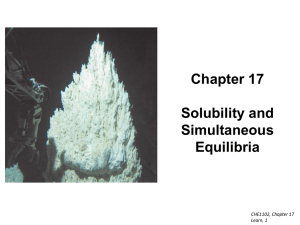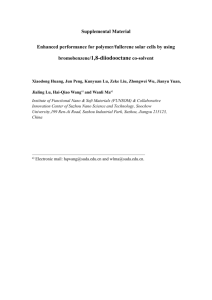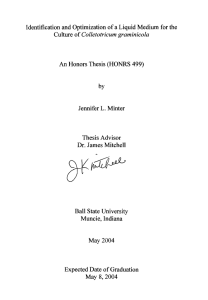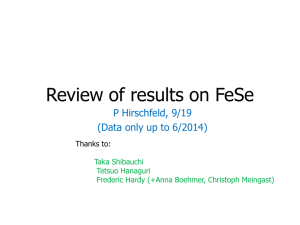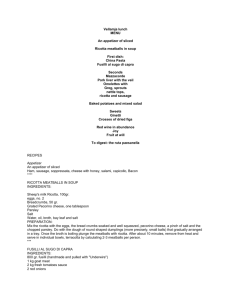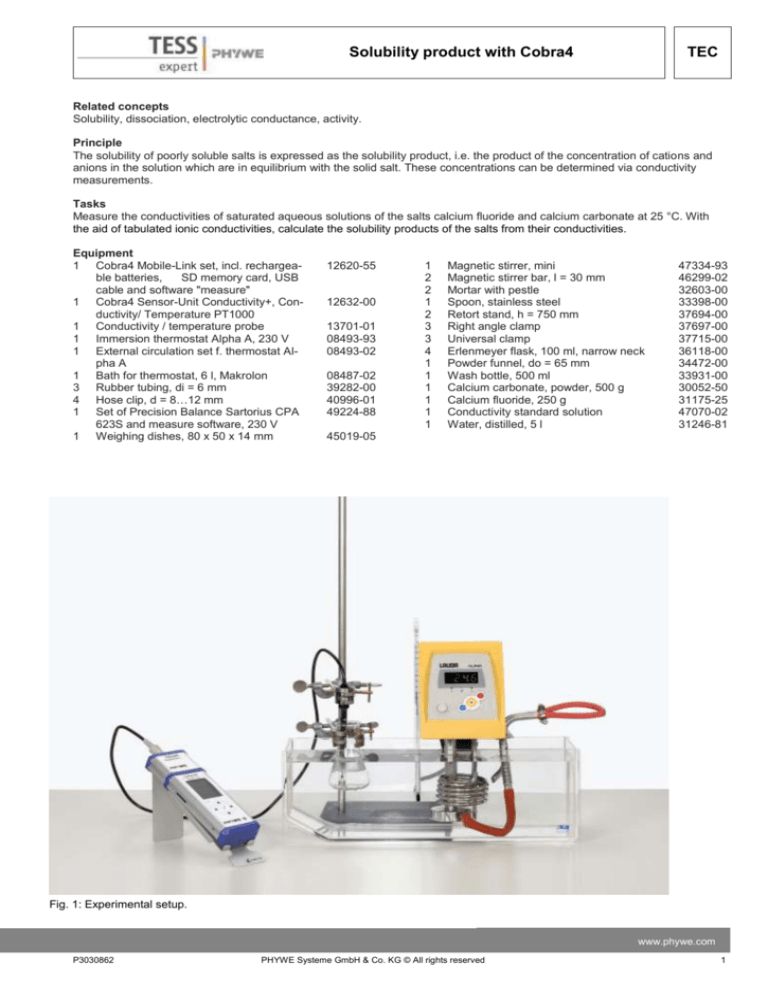
Solubility product with Cobra4
TEC
Related concepts
Solubility, dissociation, electrolytic conductance, activity.
Principle
The solubility of poorly soluble salts is expressed as the solubility product, i.e. the product of the concentration of cations and
anions in the solution which are in equilibrium with the solid salt. These concentrations can be determined via conductivity
measurements.
Tasks
Measure the conductivities of saturated aqueous solutions of the salts calcium fluoride and calcium carbonate at 25 °C. With
the aid of tabulated ionic conductivities, calculate the solubility products of the salts from their conductivities.
Equipment
1 Cobra4 Mobile-Link set, incl. rechargeable batteries,
SD memory card, USB
cable and software "measure"
1 Cobra4 Sensor-Unit Conductivity+, Conductivity/ Temperature PT1000
1 Conductivity / temperature probe
1 Immersion thermostat Alpha A, 230 V
1 External circulation set f. thermostat Alpha A
1 Bath for thermostat, 6 l, Makrolon
3 Rubber tubing, di = 6 mm
4 Hose clip, d = 8…12 mm
1 Set of Precision Balance Sartorius CPA
623S and measure software, 230 V
1 Weighing dishes, 80 x 50 x 14 mm
12620-55
12632-00
13701-01
08493-93
08493-02
08487-02
39282-00
40996-01
49224-88
1
2
2
1
2
3
3
4
1
1
1
1
1
1
Magnetic stirrer, mini
Magnetic stirrer bar, l = 30 mm
Mortar with pestle
Spoon, stainless steel
Retort stand, h = 750 mm
Right angle clamp
Universal clamp
Erlenmeyer flask, 100 ml, narrow neck
Powder funnel, do = 65 mm
Wash bottle, 500 ml
Calcium carbonate, powder, 500 g
Calcium fluoride, 250 g
Conductivity standard solution
Water, distilled, 5 l
47334-93
46299-02
32603-00
33398-00
37694-00
37697-00
37715-00
36118-00
34472-00
33931-00
30052-50
31175-25
47070-02
31246-81
45019-05
Fig. 1: Experimental setup.
www.phywe.com
P3030862
PHYWE Systeme GmbH & Co. KG © All rights reserved
1
TEC
Solubility product with Cobra4
Set-up and procedure
Set up the experiment as shown in Fig. 1. Dissolve 2 g of CaF2 and 2 g of CaCO3 each in 50 ml of distilled water in separate Erlenmeyer flasks (pulverise the salts with the mortar and pestle before weighing). In addition, prepare a third Erlenmeyer flask
with 50 ml of distilled water and a further one with 50 ml of calibration standard solution. Put magnetic stirrer bars in the two
flasks with the salts, heat them to approximately 60 °C in the water bath, and subsequently stir them for 30 minutes at room
temperature on a magnetic stirrer. To perform the measurements, set the temperature-controlled bath to exactly 25 °C and temperature equilibrate the four Erlenmeyer flasks. Use the calibration solution to calibrate the conductivity probe. Measure the
conductivities of the distilled water and the salt solutions, whereby the measuring probe should only be immersed in the clear
solutions without stirring up the solid phase. Thoroughly rinse the conductivity probe before each new measurement. Substract
the conductance value of the distilled water from that of the salt solutions.
Theory and evaluation
A poorly soluble salt with the general form Mz+v+ Xz-v- (z+ and zare the charge numbers of the ions) forms anions and cations in
aqueous solution according to:
Due to the extreme dilution, the equilibrium constant Ks can be replaced by the solubility product L:
In contrast to the equilibrium constant, the solubility product is a function of the concentration (salting-out effect). The saturation
concentration cs of a dissolved salt is as follows:
Substitution in equation (2) results in:
The saturation concentration can be determined conductiometrically. To do so, the ionic conductivities for infinite dilution ∆M, ∆X
are used (Table 1):
X Specific conductance of the electrolyte solution
Transposing according to cs, the following is obtained:
Substituting in equation (4), the solubility product can now be calculated.
Table 1: Ionic conductivities at infinite dilution
Data and results
2
PHYWE Systeme GmbH & Co. KG © All rights reserved
P3030862
Solubility product with Cobra4
TEC
Solubility products:
CaF2:
4.43 · 10-11 (lit.: 3.4 · 10-11) mol3 · l-3
CaCO3: 6.82 · 10-8 (lit.: 4.96 · 10-9) mol3 · l-3
The conductivity of solutions is strongly affected by even minute traces of contaminants. Thus, for the measurement of the solubility product of calcium carbonate, the measured value is falsified by dissolved carbon dioxide from the air. As a result of the
formation of hydrogen carbonate, the solubility increases and consequently the conductivity also.
www.phywe.com
P3030862
PHYWE Systeme GmbH & Co. KG © All rights reserved
3


